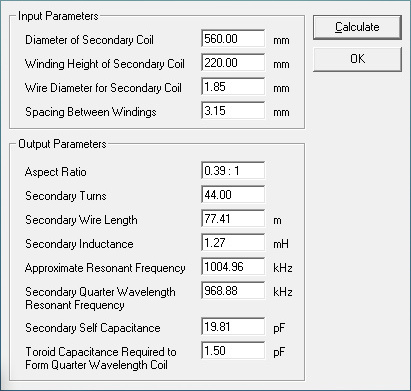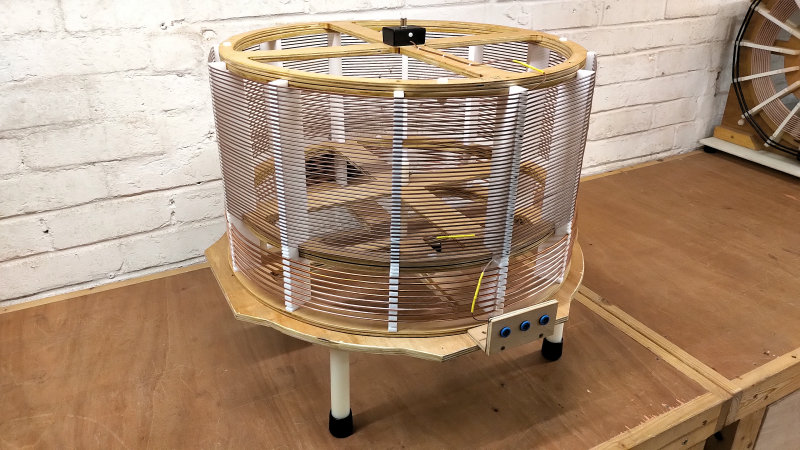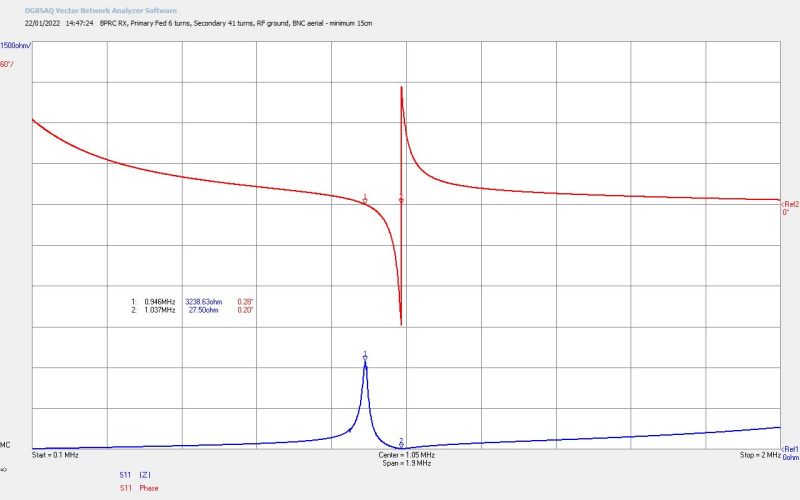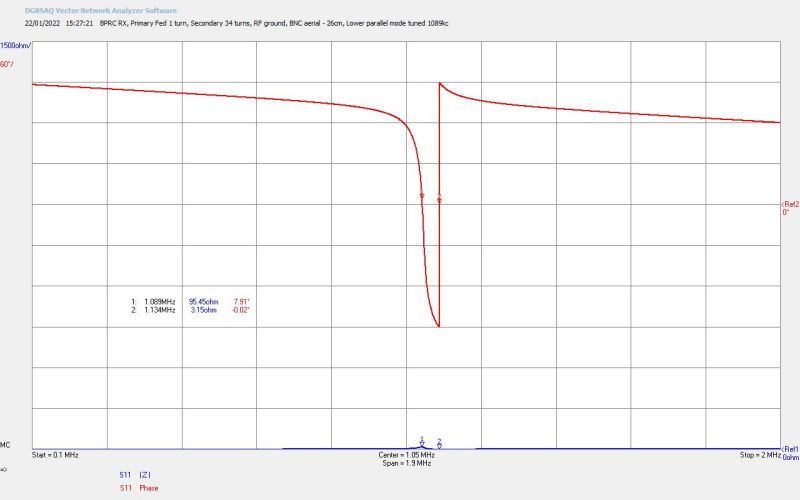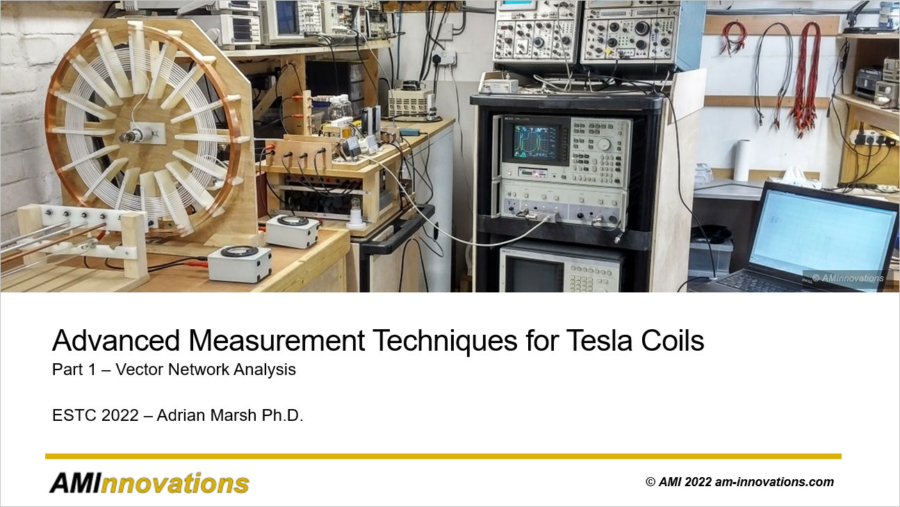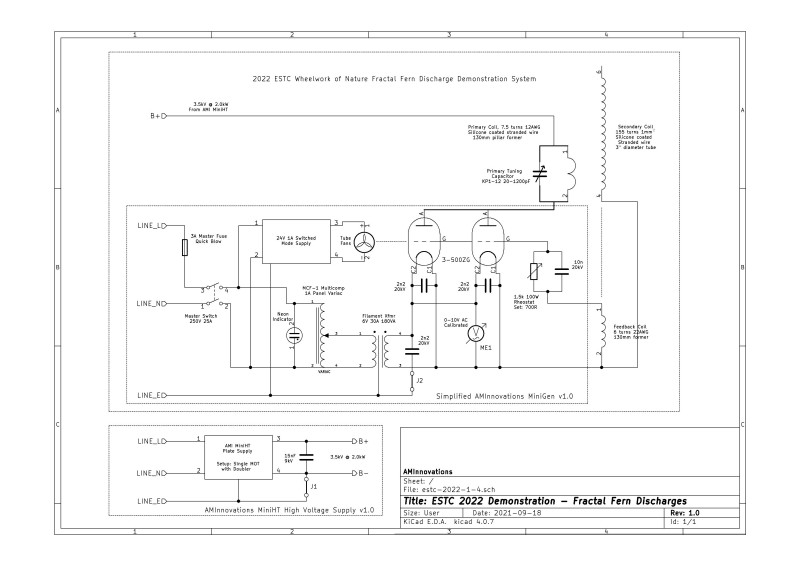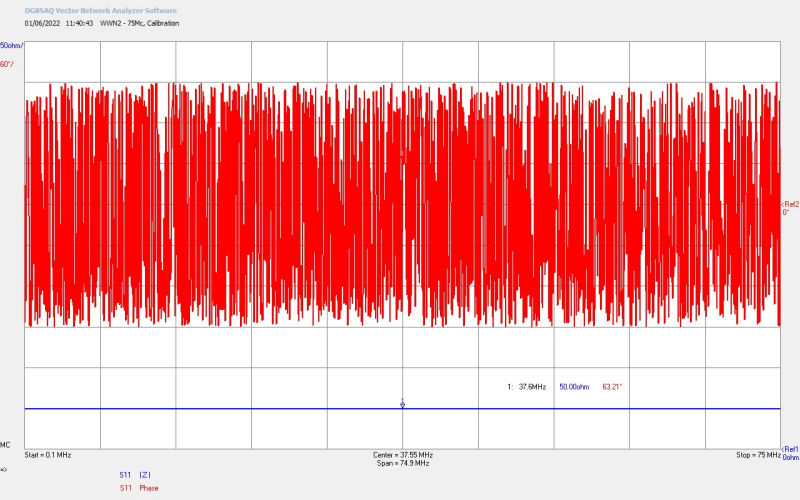In this post we continue to explore telluric transference of electric power, by using a Tesla transformer receiver 300 metres from Brookmans Park AM Radio Transmitter. The radio transmitter broadcasts four stations in the medium frequency band (MF) in the south-east of England, and is one of the most powerful AM broadcast transmitters in the United Kingdom, nominally rated at 150kW @ 909kc, and 400kW @ 1089kc, along with two other higher frequencies. A specifically designed and tuned Tesla transformer receiver, which can be tuned both at 909kc and 1089kc for both the series and parallel resonant modes, is used to receive power from the transmitting station, both through the normal transverse radio-wave above the ground, and through the telluric-wave under the ground. This telluric experiment is very similar to the crystal radio initiative (CRI) originally proposed by Eric Dollard, where a Tesla transformer was to be used to power a 100W light bulb using power transferred through the ground from a broadcast AM radio transmitter. The CRI required specific design of the receiving Tesla coil and ground system, optimised for receiving power from the telluric wave. In this experiment we demonstrate a Tesla transformer that receives ~55mW of power combined in the radio and telluric wave, using a very good ground system, and in very close proximity, around one wavelength, to the radio transmitter.
Brookmans Park AM Radio Transmitter[1-3] (BPRT), was designed and constructed in the early 1920s by the British Broadcasting Corporation (BBC) as a powerful dual-frequency transmitter to serve London and the home counties, and replace the dedicated single frequency transmitter in the centre of London. The site was originally developed with twin T-antennas, a form of electrically short monopole antenna which is capacitively loaded at the top in order to maximise radiated power. The twin T-antennas allowed broadcast on two frequencies, and were driven by a tube RF generator housed in the transmitter station, and powered from a series of onsite dynamos, references[1-3] give an interesting and comprehensive early history of the radio station. Subsequently two mast antennas were added to the site, which when phased correctly created a more directional broadcast towards London, and in later years served as individual antennas for more broadcast frequencies. Today the Brookmans Park site transmits on four AM frequencies, and has a range of satellite telecommunications, and FM applications. The video experiment includes a brief walk through Brookmans Park to see the various antennas, layout, and considerations as to their applicability to telluric transference of electric power experiments. Although four frequencies were available at BPRT[4], 909kc @ 150kW, 1089kc @ 400kW, 1215kc @ 125kW and 1458kc @125kW, the two lowest frequencies were selected as the most suitable for telluric transference of power (keeping the frequency as minimum as possible), and of these two, 909kc was found to produce the best power output at the receiver, (even despite 1089kc being at a higher transmitter power).
The crystal radio initiative[5] was devised by Eric Dollard on the Energy Science Forum[6] around 2012, with the objective, “to scale a crystal radio set, a step at a time, into a Tesla Transformer for the reception of medium wave band, 300–3000kc AM broadcasts” … “A Tesla Magnification Transformer, properly proportioned can, in theory, actually draw power from a local 50 kW station. Several hundred watts of power reception is likely. This would prove Tesla once and for all, no antenna, just a good ground, and a nice and bright 100 watt light bulb”. In conventional broadcast radio transmission a monopole antenna, such as a vertical mast or T-antenna, consists of a radiating mast above ground, and a radial conductive ground plain, usually buried just below the surface of the ground, and consisting of many copper radial conductors extending from the base up to a quarter wavelength away from the mast base. The generator via a tuning network, is connected directly across the vertical mast and the radial ground-plane and transmits a vertically polarised radio-wave omni-directional from the mast. The radial ground plane must be a very low impedance at the transmitted frequency, typically < 2Ω, and is intended to properly terminate the displacement current from the vertical mast, forming a very low return impedance to the generator. In this way losses in the system are minimised and the broadcast transmitter is optimised for maximum transmission of the radio-wave, (or ground-wave in normal radio terminology, and not to be confused with the telluric-wave).
At Brookmans Park at 909kc the transmitter is nominally rated at 150kW. Now if only 1% of this power were able to escape through the ground-system then up to 1.5kW may be available for transference to a receiver system. For this to happen in the MF band the power needs to not be absorbed by the earth, and also be in the correct transmission mode. The radio transmitter is a conventional transverse electromagnetic (TEM) transmission source, and the Tesla transformer receiver is designed for the longitudinal magneto-dielectric (LMD) mode formed in the cavity of the secondary. In a Tesla Magnifying Transformer system (TMT) where both the transmitter (TX) and receiver (RX) are LMD transformers, it is conjectured that large amounts of power can be transferred at high efficiency over very large distances, with very low losses, and at very low frequencies ~ 45kc. In this experiment and in the CRI case we have a TEM transmission mode radio transmitter at 909kc, with what would be considered leakage power from the ground system, and provided this power is not absorbed by the earth, could be transferred to an LMD Tesla transformer with a good ground system via the telluric wave. This is the case of a TEM TX transformer with an LMD RX transformer, and at a higher frequency that is easily absorbed in the earth, so it forms a particularly interesting experiment to see what level of power, if any, can be received by the Tesla transformer receiver, and what level of load could be driven from this harvested power.
The video experiment demonstrates and includes aspects of the following:
1. An introduction to Brookmans Park AM Radio Transmitter Station, broadcasting 150kW @ 909kc, and 400kW @ 1089kc, along with two other additional AM frequencies.
2. The configuration of the vertical mast and T-antenna monopole antennas on the site, to form a phased directional transmitter (TX), and optimised for ground-wave transmission of the transverse electromagnetic mode (TEM).
3. A brief introduction to Eric Dollard’s crystal radio initiative (CRI), the challenge to power a 100W incandescent lamp using a Tesla coil transformer, and using an AM Broadcast radio station as the generator.
4. A modular Tesla coil transformer receiver (RX) designed to tune both the parallel and series resonant modes to 909kc and 1089kc, corresponding with two of the station’s transmitting frequencies, and optimised for the longitudinal magneto-dielectric (LMD) transmission mode.
6. At 300m from the transmitting station antenna, in the near-field and within the induction field of the TX, a maximum of ~55mW of power could be measured using an HP435B with HP8481H thermocouple sensor, and with RX tuned to the parallel mode at 909kc, and using a tested good ground connection.
7. The telluric wave was measured to contribute ~39mW to the total received power, and the radio wave ~16mW of power, showing that more power was received directly through the telluric channel between TX and RX.
8. The received power was sufficient only to power an LED, and no significant voltage tension was measured across the secondary coil terminals. A 0.5W and 3W neon lamp, along with a 5W incandescent lamp could not be illuminated.
9. It is conjectured that the very low received power of ~55mW from a transmitter output of up to 150kW only 300m distant, results from a combination of the following:
a. The mismatch between TX (TEM) and RX (LMD) transformer modes.
b. High absorption of power by the earth close to the TX ground system at 909kc.
c. Inadequate electrical tension developed across the secondary coil of the Tesla transformer receiver, which suggests no LMD mode is developed between TX and RX transformers.
Design of Tesla Transformer Receiver coil
Telluric transference of electric power experiments thus far reported on this website have been conducted at 1860kc in the 160 metre amateur band, and using a Cylindrical Coil design. These experiments have demonstrated so far that 1860kc in the MF band is too high a frequency for a Tesla TMT system, as almost all of the RF power is absorbed by the earth in very close proximity to the transmitter ground system. In order to improve on these experiments lower frequencies are being investigated, and including this experiment at 909kc at Brookmans Park. Operating at lower frequencies means larger coils, and hence it was considered to design a more modular coil system consisting of a generic base, and with interchangeable, and extendable primary and secondary coil systems to work at a range of different frequencies, both with and without an extra coil.
For the opening experiment at Brookmans Park a dual frequency secondary coil was designed to allow the receiver to work at both 909kc and 1089kc for both the series and parallel modes of the coil. The primary was developed to have up to 8 configurable turns to tune the optimal balance between quality factor of the resonant mode, and the magnetic coupling coefficient k between the primary and secondary coils. The primary coil turn number and position can be selected via a jumper system on a turn by turn basis from only 1 turn, up to a full 8 turns. In practise and after measurement 6 turns of the primary was found to be optimal for the secondary coil used, and this will be considered later in the small signal ac input measurements.
The design of the Tesla transformer receiver starts with the secondary coil, and using design characteristics previously empirically determined to be optimum for transference of electric power experiments using a TMT system. Much more detail on these characteristics and how they were determined can be found in the experimental and measurement posts in Transference of Electric Power, and Tesla Coil Geometry and Cylindrical Coil Design. For this design without an extra coil the following was used:
1. A low aspect ratio width to height, loosely wound, cylindrical coil section, based on a 56cm diameter coil which can be used into the low-end of the MF frequency band, down to ~ 475kc with additional secondary coil sections added in a modular construction, or with a third extra coil design.
2. A secondary conductor spacing-turns ratio of ~63%, using a 1.85mm diameter RG178 coaxial conductor with a 5mm turn pitch.
3. A primary conductor with spacing-turns ratio of ~67%, using a 3mm diameter copper tube with a 9mm turn pitch.
4. A vertically stacked primary and secondary with ~25-50mm spacing between coils, and dependent on the configuration of secondary coil frequency (909kc or 1089kc).
5. Possibility for selection of equal weights of conductors in the primary and secondary coils through primary turn number, and to be best balanced with the impedance, quality-factor (Q), and magnetic coupling coefficient k between both coils.
6. Theoretical resonant frequency for 909kc and 1089kc to incorporate a telescopic aerial at the secondary top-end to tune the series or low parallel resonant mode of the Tesla transformer to the exact frequencies of the radio transmitter. In this case the theoretical design needs to add between 100-150Hz to the desired resonant frequency, which will then lower to the target frequency with the addition of the telescopic aerial.
With consideration of these design characteristics the theoretical secondary coil design using Tccad 2.0 is as shown in Figures 1 below.
In practise when the small signal ac impedance measurements were made with the DG8-SAQ USB vector network analyser (VNWA) the number of turns were reduced slightly from the theoretical design. With the telescopic aerial at a minimum extension of 15cm at the secondary top-end, and a good RF ground connected to the secondary bottom-end, the lower parallel mode could be tuned for 1089kc with 34 turns, and for 909kc with 41 turns. In both cases with the telescopic aerial maximally extended, the series mode could also be tuned at 1089kc and 909kc, providing flexibility and simple configuration during the field experiments.
The 1089kc coil was wound with a 2mm terminal connector at each end, so the additional 7 turns for the 909kc could be added at the lower end of the coil without any need for unwrapping windings from the coil former. The extra turns can be placed at the top or bottom-end of the secondary coil, but in this case the bottom-end was used to add extra turns, and in order to simplify tuning at the high impedance end of the coil, where the quality factor and magnification is at its maximum. Adding turns at the bottom-end also requires a change in configuration of the primary coil turns (by the jumpers), in order to accommodate for the change in magnetic coupling coefficient k with increased physical distance between the 909kc and 1089kc coil bottom-end. The optimum number of primary coil turns to start with is determined during the small signal ac impedance measurements, and then adjusted slightly up or down during the actual field experiment.
Figures 3 below show some of the construction features of the vertical cylindrical coil design, including the modular coil construction and base, the secondary coil former, mounting, windings and coil frequency configuration, and the primary coil former, windings and configurable turns electrical connections. It is interesting to note that the secondary coil is designed with turns right to the upper end of the former. This construction method allows another secondary to be placed on top of the first, connected with inline 2mm connectors, and with a direct continuation of the windings with the same conductor and turns pitch, and hence making a modular and extensible coil system to address a wide range of different frequency experiments. The system can be extended functionally down to 475kc with a secondary coil only, and even further to lower frequencies when an extra coil design is used. These lower frequency designs and experiments will be reported subsequently on the website, and are mentioned here to give the reader an understanding of the scope and flexibility of the this experimental design.
Small Signal AC Input Impedance Measurements
Figures 4 below show the small signal ac input impedance Z11 measured directly on the complete Tesla coil transformer at both 909kc and 1089kc. The transformer was measured with a telescopic aerial at the top-end for fine tuning, and a good RF ground at the bottom-end as would be the case in the field experiments at Brookmans Park. These measurements were made using an SDR-Kits VNWA vector network analyser, as used on many experimental pages on this site.
To view the large images in a new window whilst reading the explanations click on the figure numbers below.
Fig 4.1. Here the secondary coil is configured with 41 turns for 909kc tuning, and the aerial has been set to minimum extension. The parallel mode @ M1 is at 946kc, and the series mode @ M2 is at 1037kc. This is the highest frequency of tune for the 909kc secondary and means that through extension of the telescopic aerial both the parallel and series modes can be tuned to the required frequency. The primary has been set to the optimum 6 number of turns which achieves the best balance between high quality factor of the secondary coil, and magnetic coupling k coefficient between the primary and secondary coils.
Fig 4.2. The telescopic antenna has been extended to 40cm which increases the wire length at the top-end of the secondary coil, reducing the resonant frequency of both parallel and series modes. Here the parallel mode @ M1 is now correctly tuned to 909kc, and the series mode @ M2 of 1001kc.
Fig 4.3. With further increase in telescopic aerial extension to 106cm the series resonant mode is now correctly tuned to 909kc and the parallel mode has fallen further @ M1 to 834kc.
Figs 4.4, 4.5, and 4.6. Show the same process for the 34 turn secondary configured for 1089kc tuning.
Figures 5 below show the small signal ac input impedance Z11 measured directly on the Tesla coil transformer at 1089kc from 1 primary turn up at the full 8 primary turns. All figures are presented on the same vertical and horizontal scales to allow for direct comparison as the number of primary turns increases.
At 1 turn the coupling to the secondary coil is very low, it is under-coupled, which is insufficient to properly develop the parallel and series modes. At 2 turns the coupling has improved a bit but is still insufficient to properly develop the two resonant modes properly. From 3 turns up to 6 turns the coupling increases considerably, and all of these turn taps could be used to operate the Tesla transformer, where 6 turns is the optimum balance between the high quality factor, and hence free resonance of the secondary coil, and optimum coupling to the primary, and hence well developed parallel and series modes transformed into the primary. At 7 and 8 turns the secondary coil is over-coupled with the primary, the Q factor of the secondary is damped down, and the receiver starts to become too dominated by the characteristics of the primary, or tending towards force “driven” by the primary.
Used as a transmitter or receiver coil, 6 turns has been found to be best with this specific cylindrical coil design, in terms of its impedance and coupled characteristics. Where equal weights of copper in the primary and secondary coils is significant to the type of experiment and intended purpose of the system e.g. in a high-efficiency TMT system optimised for the LMD mode, where you achieve the best transformation efficiency and balance of the TEM and LMD modes with the most continuous boundary conditions in the transformer, (equal weights or surface areas of conductor dependent on frequency band of operation). For more details on these boundary conditions and the optimal tuning of a TMT system see the Transference of Electric Power series.
Experimental Results, Considerations, and Conjectures
This experiment demonstrated that ~55mW of power could be received in a Tesla coil transformer, tuned at 909kc at the parallel resonant mode of the coil, when attached to a very good RF ground, and at a distance of 300m from a 150kW broadcast radio transmitter at the same frequency. It was determined by measurement that the telluric wave contributed ~39mW to the total received power, and the radio wave ~16mW of power, showing that more power was received directly through the telluric channel between radio transmitter and the RX coil. The level of received power was sufficient only to light an LED bulb either by the radio-wave on its own (no direct ground connection), or by the telluric and radio-wave combined. It was also noted using two different neon bulbs that no significant tension was established across the secondary coil when connected to either the on-site ground node, or by a ground rod driven into the ground in the same proximity, or by the radio-wave alone when retuned and not connected directly to ground. The presence of very little tension across the secondary coil would makes it impossible to extract any useful power from the Tesla transformer receiver, and the tension of the coil and the level of the received power at 55mW is consistent.
To illustrate what is meant by tension across the Tesla coil secondary let us consider what is necessary to light a 100W light bulb using such a transformer. This experiment can be done on the bench with a generator using a suitable amateur radio exciter or linear amplifier, or a high-power oscillator arranged to oscillate at the correct frequency. The generator is connected in reverse on the Tesla transformer with the ‘hot’ terminal of the generator output connected to the bottom-end of the secondary coil, and the ground terminal connected down to a good RF earth, and is arranged to output 100W of power at the series resonant frequency of the secondary coil. The primary coil is connected only to the two terminals of a 100W incandescent lamp, the number of turns on the primary having been arranged to best match the impedance of the incandescent lamp when fully illuminated for maximum power transfer. There will of course be minor losses in receiving the power in the load through the optimised Tesla transformer, and with careful arrangement these can be < 1%.
With this experiment arranged and operational it can be seen that in a well matched and tuned condition ~ 100W of power from the generator will fully illuminate the incandescent lamp. In this condition a neon lamp will show a strong potential gradient across the windings of the secondary coil, from a maximum at the top-end and to a minimum at the bottom-end. This tension across the secondary coil is easily in the range of kVs, and enough also to draw a small streamer of the top of the secondary coil with a fluorescent bulb or other lower impedance receptacle. So, to light a 100W incandescent lamp, or even for that matter a 5W incandescent lamp, using a Tesla transformer, there will always be a certain tension across the secondary coil. With this established it is clear that the experiment at Brookmans Park, even in close proximity to a very powerful radio transmitter, no significant tension was generated across the secondary coil, either from the induction field from the transmitter, the received radio-wave, or the received telluric-wave. Indeed if that much tension was present then I would expect to get an electric shock or RF burn simply by touching the on-site ground node or earth rod in the experiment. Clearly the quantity of power required for such tension is not being passed through the earth by any transmission mode, and hence was not available for harvesting by the Tesla transformer receiver.
In the telluric experiment Transference of Electric Power – Single Wire vs Telluric ~45mW of power was transferred through a telluric channel 18m point to point between the ground system and connections, with 500W of power supplied to the primary of the transmitter Tesla transformer. It was conjectured that almost all of the transmitter power @ 1860kc was absorbed into the ground at very close proximity to the ground system, and very little of the supplied power was able to reach the receiver Tesla transformer, which also appears to be the case in this Brookmans Park experiment. Even if 1% of the transmitter power escapes the radial ground plane, that is ~1.5kW @ 909kc, and almost all of this is absorbed in the earth, leaving only ~39mW of received power from the telluric-wave 300m from the base of the transmitter antenna. It is conjectured that based on these experiments that 909kc is still far too high a frequency for practical transference of electric power using the telluric-wave. It should also be considered here that the Tesla transformer receiver may need to be arranged so as to “draw” the power through the ground from the transmitter, in a more coherent manner than simply being arranged as a receiver connected to a ground node and tuned to the transmitter frequency. Then it may be that the receiver can be tuned in some other fashion that would enable power to be drawn from the transmitter, and this needs to be investigated further.
The other important consideration is that this experiment is between an antenna optimised for TEM broadcast radio transmission, and a Tesla transformer intended to draw power from the cavity in the LMD mode. In this sense the fundamental design and principle of operation of the TX and RX system is different, and they are intended to work with different configurations and modes of the magnetic and dielectric fields of induction. This may also be a significant reason why so little power could be extracted from close proximity to a powerful transmitter. In effect there is no “cavity” between the TX and RX in this case. In an ideal TMT apparatus, the LMD mode is tuned in the cavity formed between and including the TX and RX secondary coils. When the LMD mode is at its maximum equal tension can be accomplished across both the TX and RX secondary coils, ideally the bottom end of each coil is at zero potential, the point of maximum current into the ground system and transmission channel, and one or more potential nulls or zero points form along the length of the transmission medium. Hence the LMD mode is established across the cavity and electrical energy is passed back and forth across the cavity in a way very similar to light in a laser cavity. Tuned correctly the LMD mode can transfer considerable power between the TX and RX coils across the cavity, and at very high efficiencies over 99%. More details and practical experiment and demonstration of this can be found in High-Efficiency Transference of Electric Power – 11m Single Wire and High-Efficiency Transference of Electric Power posts.
So in this experiment where the generator and TX coil is a TEM broadcast radio station, we do not have a TMT arrangement with a tuned cavity between TX and RX, optimised for the LMD transmission mode, and hence we would not expect to achieve high-efficiency transference of electric power in this arrangement. It maybe that with adjustment of the RX coil it may be able to “draw” more power from the earth, but I would anticipate this also to be at a much lower frequency where less of the RF power is absorbed around the transmitter ground system. The radio transmitter is after all designed to minimise the power loss from its ground system, and maximise the power supplied to the TEM transmission mode via the ground-wave.
Conclusions and Next Steps
In summary conclusions, the very low power received in close proximity to a very high power radio transmitter is conjectured to be as a result of the following:
1. Mismatched transmission modes of the TX (TEM) and RX (LMD), where there is no tuned cavity formed between the two in the telluric channel as there would be in a complete TMT system.
2. The frequency of the transmitter at 909kc leads to very high power absorption losses in the earth close around the transmitter ground system, resulting in very little transferred power through the ground up to one wavelength from the transmitter base.
3. The tension or “pressure” exerted on the Tesla transformer receiver coil was very low even when connected to a substantial on-site ground node, and hence only ~55mW could be transformed into the primary circuit at the receiver. The available electrical energy at the on-site ground node was insufficient to be detected by human contact.
4. The telluric-wave was measured as larger by a factor of 3 than the radio-wave received at one wavelength using the Tesla transformer, which appears surprising when the RX coil is still within the induction field of the transmitter antenna.
The design of the Tesla transformer receiver used in this experiment is a direct tuned secondary coil which does not include in itself a third resonant coil, Tesla’s extra coil, which changes the characteristics of the transformer in a number of important ways. The characteristics of Tesla’s extra coil will be discussed and demonstrated in subsequent posts on this site. Next steps to the experiment presented would include a three-coil receiver design “properly proportioned”, and tuned to work with the Brookmans Park radio transmitter, which may produce a different result and be able to “receive”, “draw” or “extract” more power in accordance with what was at least theoretically expected in the crystal radio initiative.
Click here to continue to the next part, looking at Telluric Transference of Electric Power – MF Band 27-70 Miles.
1. Caras, L., A History of Brookmans Park Transmitting Station, 1982, North Mymms History Project
2. Gutteridge, P., Brookmans Park – Pictures and Memories, 1974, BBCeng.info
3. Pennington, A., Brookmans Park – A Brief History, 2013, British DX Club
4. Wikipedia. Brookmans Park Transmitting Station, Wikimedia Foundation Inc., Wikipedia, 2022.
5. Dollard, E. and Forum Members, Eric Dollard Official Forum -> The Crystal Radio Initiative, Energetic Forum, 2012.
6. Dollard, E. and Energetic Forum Members, Energetic Forum, 2008 onwards.
7. A & P Electronic Media, AMInnovations by Adrian Marsh, 2019, EMediaPress



